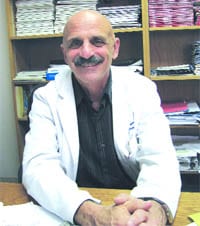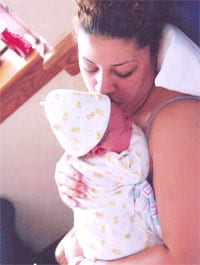A Matter of Time When a Heart Attack Strikes, Quick Action Can Save a Life
Sometimes people get a harsh reminder of a health issue they should give more attention. And sometimes, they get two.
That’s how advocates for heart health saw the sudden deaths earlier this year of newsman Tim Russert and comedian George Carlin, who suffered life-ending heart attacks just nine days apart. The tragedy is so common, however — about 1.1 million Americans are stricken with heart attacks each year, about half of them fatal — that most people can find similar tragic examples from their own circle of family and acquaintances.
The question is, could many of these deaths have been prevented? The answer, doctors say, is an unmitigated yes, especially considering that about half of all heart-attack deaths occur during the first hour after the event, and before the patient makes it to the hospital.
“The average time delay for people to come into the hospital from the time they first have discomfort is two hours. That’s a little long,” said Dr. Marc Schweiger, director of the Division of Cardiology at Baystate Medical Center.
“The biggest risk from a heart attack is early on,” he said, noting that some heart attacks cause sudden death. But in most cases, a heart attack is a slow-moving event, and people have time to get medical intervention. But not, in many cases, very much time.
To understand why, it’s important to know exactly what a heart attack, or myocardial infarction, is. It occurs when blood flow to a section of heart muscle becomes blocked. If the flow of blood isn’t restored quickly, the section of heart muscle becomes damaged from lack of oxygen and begins to die.
Heart attacks occur most often as a result of a condition called coronary artery disease, which is typically caused by a fatty material called plaque that builds up over many years on the inside walls of the coronary arteries, which supply blood and oxygen to the heart. Eventually, an area of plaque can rupture, causing a blood clot to form on the surface of the plaque. If the clot becomes large enough, it can mostly or completely block the flow of oxygen-rich blood to the part of the heart muscle fed by the artery.
During a heart attack, if the blockage in the coronary artery isn’t treated quickly, the heart muscle will begin to die and be replaced by scar tissue. This heart damage may not be obvious, or it may cause severe or long-lasting problems. That’s why cardiologists tend to use the expression “time lost is muscle lost” when driving home the importance of getting help right away.
“It’s very important that you seek timely care for a heart attack,” said Dr. Nirav Sheth, a cardiologist with Hampden County Cardiovascular Associates. “A lot of people think it’s indigestion or something else, and they try to ignore it and hope it goes away. But if you delay care, you already have damage done, and the doctor might not be able to get the muscle back to normal function.”
Is It a Heart Attack?
According to the American Heart Assoc., people having a heart attack often aren’t sure what’s wrong, and they wait too long before getting help. But there are some common signs to watch for:
- Chest discomfort. Most heart attacks involve discomfort in the center of the chest that lasts more than a few minutes, or that goes away and comes back. It can feel like uncomfortable pressure, squeezing, fullness, or pain.
- Discomfort in other areas of the upper body. Symptoms can include pain or discomfort in one or both arms, or perhaps the back, neck, jaw, or stomach.
- Shortness of breath. This may occur with or without chest discomfort.
- Other signs. These may include breaking out in a cold sweat, nausea, or lightheadedness.
As with men, women’s most common heart attack symptom is chest pain or discomfort. But women are more likely than men to experience some of the other common symptoms, particularly shortness of breath, nausea or vomiting, or pain in the jaw or back.
“If you are experiencing a major symptom like chest pain or chest pressure which is severe and pressure-like, or having associated symptoms, such as getting sweaty, shortness of breath, or lightheadedness, definitely seek medical attention,” Sheth said.
“Not everyone has classic symptoms, and women tend to have more atypical symptoms,” he added. “If you have jaw pain or arm pain that starts suddenly, or you suddenly have a severe feeling that something’s not right, seek attention. Many times women who have shortness of breath don’t think they need to be evaluated, but that could signify a lot of issues, one of which is a heart attack.”
Along with medical community’s increased focus these days on acting quickly when a heart attack strikes, interventional treatments have advanced as well. For example, Baystate is the only regional hospital with a catheterization lab.
That’s important, Schweiger said, because when someone has a heart attack where the artery supplying blood to the heart is totally blocked by a clot, the best course is to treat the clot and open up the artery. There are two ways to do that: with a clot-dissolving drug, and bringing the patient directly to a cath lab and opening the artery using catheterization and angioplasty, which involves inserting a balloon into the artery to expand it.
Speed is crucial, Schweiger said, and area ambulances equipped to stabilize heart-attack victims will transport patients to Baystate if it’s not more than 20 minutes farther away than the next-closest hospital.
Reducing the Risk
Risk factors for heart attacks are many, including family history, hypertension, diabetes, high cholesterol, and a sedentary lifestyle, but the most significant, Schweiger said, is smoking — not just for the real danger it poses to heart health, but because it’s one of the few risk factors that can be modified.
Specifically, the nicotine present in smoke causes heart disease by decreasing oxygen to the heart, increasing blood pressure and heart rate, increasing blood clotting, and damaging the cells that line coronary arteries and other blood vessels.
“It definitely helps to quit smoking,” Sheth said, “not only because it lowers the risk of heart attacks, but the risk of lung disease and cancer go down, too,” even if someone has smoked for many years.
There seems to be some evidence backing up the claim. A recent study conducted by the Mass. Department of Public Health and the Harvard School of Public Health concludes that nearly 600 fewer Bay State residents have died from heart attacks each year since a statewide ban on smoking in almost all restaurants, bars, and workplaces took effect four years ago — a law that essentially makes it more difficult to light up and easier to avoid second-hand smoke.
The study also suggests that the number of heart attacks began dropping in communities with strong anti-smoking laws even before the 2004 law.
“This is the strongest study yet done of the effect of smoking bans on heart attacks,” said Dr. Michael Siegel, a Boston University School of Public Health specialist in tobacco control, in the Boston Globe. “You can no longer argue that these declines would have occurred simply due to medical treatment.”
Schweiger certainly isn’t arguing the point.
“I think people who have heart disease in their family really have to be vigilant,” he said. “Of course, everyone should, when it comes to not smoking, seeking medical care, maintaining a healthy lifestyle, and eating healthy foods. All these things are important.”
After all, the best way to treat a heart attack is not to have one. But for those who do — or even suspect they might be having one — there’s nothing more important than time.
“Obviously, you’re not going to run to the emergency room with just any discomfort,” Schweiger said. “If you’re a 22-year-old woman, it’s less likely to be a heart attack than if you’re a 60-year-old guy. So there’s some common sense involved. But if you’re ignoring discomfort that’s not going away, that’s probably not a good idea.”



Comments are closed.